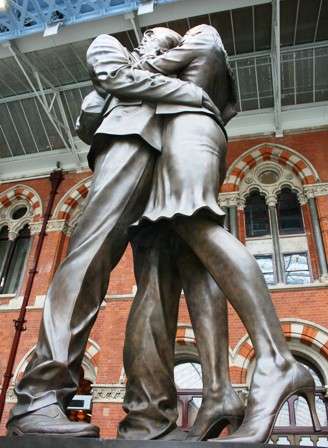
The Arcelor-Mittal Orbit: coming to an Olympic Games soon
Space invaders
Overwhelmed by the works of art that bedeck our streets and squares, Nick Reeves argues that greater intellectual and artistic rigour in the commissioning of public art will create better environments.

The Arcelor-Mittal Orbit: coming to an Olympic Games soon
Let us talk of the parlous state of public art and about the Twittering, free wi-fi-ing, iPhone-a-fondling metro-dudes who commission and curate it. Don’t get me wrong, there are some wonderful individual pieces of public art but Anish Kapoor’s proposed steel structure for the London Olympic Park, which has already created a stir, loved and loathed in equal measure, is unlikely to be included on the list. It is, according to architectural commentator, Hugh Pearman, “misconceived, ugly, banal, compromised and downright embarrassing... by a considerable distance the worst piece of public art”. Known as the Arcelor-Mittal Orbit, Kapoor’s piece is part-funded by (and therefore named after) billionaire steel magnate Lakshmi Mittal. Taller than the Statue of Liberty, it will be product placement on a grand scale and very, very corporate. Higher, vaguer and ghastlier than anything else perhaps but I wonder where the 1,400 tons of red tubular steel for Boris Johnson’s Olympic folly will come from? Apparently nobody could (or would) say.
Much of the public art that has appeared since the late 1960s is corporate and much is a blight on the urban environment. We now live in an era of corporate everything and those who commission corporate art are servants of monster-corporations more interested in brand and image than art’s ability to inform, to enthral and elucidate. How did it happen that cityscapes around the world come to look like a disturbing vermischen of Bauhaus, art deco, New York loft apartment and Prêt a Manger chic? How do these space invaders get to be commissioned?
A recent re-appraisal of the work of Henry Moore at Tate Britain focused on his wartime drawings of men, women and children sheltering from the blitz in London’s underground stations. The drawings are certainly haunting as well as beautiful. They tell us that Moore was a wonderful draughtsman capturing the essence of the human condition and they tell us the story of ordinary people just trying to survive the madness of a few. But Moore was a giant of 20th-century sculpture so what else did the Tate exhibition tell us about Moore and his work? First, that Moore made sculpture acceptable again after a very long time in the doldrums. With Barbara Hepworth, he put sculpture at the heart of avant-garde art and took it global. He also inspired a future generation of talented sculptors who made sculpture cool. Anthony Caro, Eduardo Paolozzi, Philip King, Brian Wall and others worked as assistants to the avuncular Yorkshireman and continued his legacy of great sculpture that achieved public approbation and critical acclaim around the world.
But it also told us that by the late 1960s and through to the 1980s sculpture itself was becoming a victim of Moore’s commercial and critical success. Every city square of any consequence in almost every country on the planet had a piece of sculpture characterised by abstracted forms and figures with holes. Moore could barely keep up with demand and was churning out huge formulaic bronzes for corporate and civic regeneration projects. The integrity and artistic merit of many of these pieces was compromised by the need to meet the expectations of corporate patrons; and muddle-headed architects and planners had to have their say. Therefore much of the work he made on commission is dubious and some of it is downright bad. The worst of the commissioned pieces morphed into a supporting role for corporate brands that represent the very worst of unsustainable urban development and for economic growth for its own sake. They are totems of a dodgy form of capitalism that spawned a decline in publicly commissioned sculpture that continues to this day.
But public sculpture is a vital element in the built and natural environment, and always has been. It expresses the sense of identity, the intellectual and artistic soul, and the moral compass of those who engender, adopt and accept it. So you would think that the obligation to spend a certain proportion of new-build costs on the commissioning of works of art would be welcome and a given. When this policy was introduced in the US about 30 years ago all that resulted was the sudden appearance of knots of steel, lumps of stone and Moore-esque bronzes, all remarkable for their vacuity, in front of every new building and in every public space. These objects – many of which seemed merely to respond grudgingly to a perceived artistic obligation – produced confusion, irritation, alienation and derision.
The most notorious is Richard Serra’s Tilted Arc in Federal Piazza in downtown Manhattan. Those living and working around it had to circumvent its enormous bulk, 120 feet long and 12 feet high. According to Serra that was the point: “The viewer becomes aware of himself and of his movement through the Plaza. As he moves the sculpture changes. Contraction and expansion of the sculpture result from the viewer’s movement. Step by step the perception not only of the sculpture but of the entire environment changes.” But the inconvenience was too much for some and they agitated for its removal. This was achieved only after a furious legal battle during which, as is usual when criticism is brought to bear on certain contemporary art manifestations, the fascist burning of books was invoked. More often, the public, while resolutely declining to be ‘educated’ into the acceptance of incomprehensible works of art, simply ignore them. On the night of 15 March 1989 federal workers moved in, cut Tilted Arc into three pieces and carted it off to a scrap yard.
It seems to me that art is only really useful when it deals with the eternal problems and questions of the human race in a manner relevant to the present. This requires a process of renewal. The sum of history is always at the service of the present and is continuously moulded to suit its particular needs; but the present is itself constantly becoming history. Public sculpture is a versatile means of expressing this process and of remembering what we have learnt, and are learning.
While there are, and continue to be, sublime examples of abstraction, I am of the opinion that most abstract art being produced today is tantamount to taking a tranquilliser or escaping to a tower. In addition, it is a simple and obvious truth that the quality of figurative sculpture is easier to judge than that of abstract, in both form and content. Too many abstract artists indulge in a coy symbolism, as if they are fearful of committing themselves to an idea or a position. The most egregious example of this is Daniel Libeskind’s claim that the height of his proposed replacement for the World Trade Center – 1,776 feet – would commemorate the Declaration of Independence. This immediately begs the question whether this significance could continue if America were to adopt the metric system. Closer to home we have the New Zealand memorial at Hyde Park Corner, the proximity of which to Jagger’s Artillery masterpiece serves only to emphasise its banality.
Good public sculpture attracts anecdote and legend. We have to understand once more that sculpture is, above all, the finding of sculptural metaphor for our perceived objective reality and recreating it, not imitating it. This may seem reactionary but this is not my intention. I am simply calling for higher standards, greater awareness and the cohesion of the past, the present and the future. Throwing everything away and starting again was the big idea of the 1960s and it has proved to be wrong. The range of reference that we can use and expect to be understood is now vast and all of it is useful. The interregnum has brought a new, better informed and sharper freedom; but artists must reject the corporate and the vacuous and come back to humanism if they want to be of any real service.
Those who commission public sculpture should understand and respond to this because it is they who ultimately bear the responsibility as to whether we are surrounded by good or bad sculpture, and good or bad built environments. It is not incompetent artists who are responsible: it is incompetent patrons. I now realise that good patrons are even rarer than good artists. It is frightening to think of the atmosphere of extreme ignorance in which such important and far-reaching choices are made. There needs to be much more artistic and intellectual rigour in commissioning public art, for everyone’s sake. We need a new understanding of this vital subject, a subject which is, and always has been, a metaphor for our own human condition.
A condition under threat as never before deserves the very best of public art and patrons who know what they’re about. The trouble with the Anish Kapoor piece is that it has to be a use-able building. This never works. Art is for art’s sake and you can do what you like (up to a point). Buildings are beset by regulations and you cannot do what you like, otherwise people might die. Try to turn a Kapoor motif into a regulation-compliant work and it loses all integrity. The “Mutant Trombone” will likely be a mash-up and expose the weaknesses of those who commission public art. Why haven’t we learned the lesson of the kitsch awfulness of the lumpen bronze not-quite-snogging couple at St Pancras Station in London?
Nick Reeves is executive director of CIWEM, the Chartered Institution of Water and Environmental Managemen. He is also an accomplished and highly opinionated artist.
The Leisure Review, July 2010
© Copyright of all material on this site is retained by The Leisure Review or the individual contributors where stated. Contact The Leisure Review for details.
Download a pdf version of this article for printing
